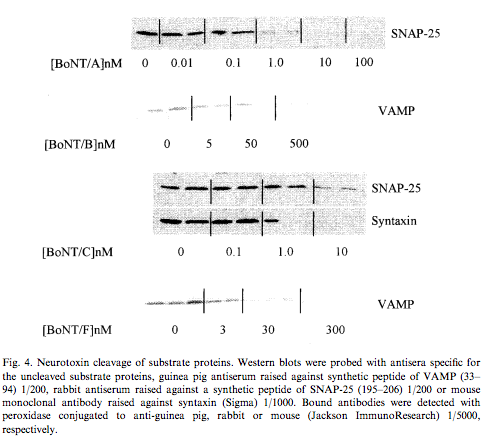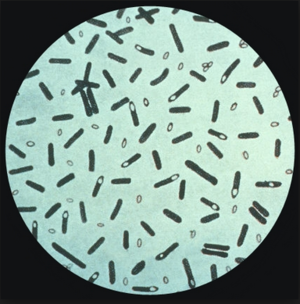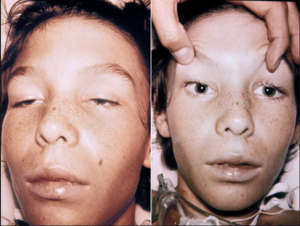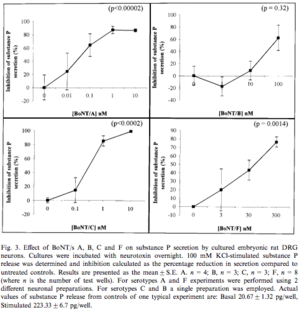Clostridium botulinum, associated neurotoxins, and botulism: Difference between revisions
| Line 1: | Line 1: | ||
==Introduction== | =<br><b><i>Clostridium botulinum</i>, Neurotoxins, and Botulism</b>= | ||
[[File:Screen Shot 2014-04-21 at 9.23.54 PM.png |thumb|300px|right|Photo of a | |||
==Introduction to <i>Clostridium botulinum</i>== | |||
[[File:Screen Shot 2014-04-21 at 9.23.54 PM.png |thumb|300px|right|Photo of a standard light microscopy field of view of <br><i>Clostridium botulinum.</i> ]] | |||
<br>By Tyler Smith<br> | <br>By Tyler Smith<br> | ||
<br> | <br>Clostridium botulinum is a Gram-positive staining, anaerobic bacterium. Clostridium botulinum is also rod-shaped, endospore-forming, and responsible for producing the neurotoxin that causes botulism. C. botulinum is mostly found in marine-sediments and soils all over the world, as evidenced by cases of botulism that have been reported in Europe, North America, and Australia (Sugiyama 1980). It can also infiltrate and contaminate any plant or vegetable that is grown in such contaminated soils, which can be a mode through which people are infected with the neurotoxin. Furthermore, when introduced through a variety of ways, it can colonize the gastro-intestinal tracts of mammals, birds, and fish. Thus, Clostridium botulinum, as well as the disease it causes, are widespread and of great interest to scientists all over the world. | ||
Clostridium botulinum causes the disease botulism, which was given the name after an outbreak of the disease in the 1700’s where all of the people who were infected had eaten from the same large sausage. In fact, the Latin word for “sausage” is “botulus”. Thus, when Emile van Ermengem published a description of the bacterium that causes the disease botulism, he called it Bacillus botulinus. However, since bacilli are predominantly aerobic microbes, the bacterium was renamed to reflect its current place in nomenclature: Clostridium botulinum (Caya et al. 2004). | |||
C. botulinum can be isolated in pure culture on TSC (tryptose sulfite cycloserine) growth media in very little (>2%) oxygen. As an obligate anaerobe, C. botulinum can actually survive small amounts of oxygen because it is equipped with an antioxidant defense enzyme, superoxide dismutase, which essentially protects the cells from damage due to oxygen exposure. As an endospore-forming organism, C. botulinum is somewhat unique. Whereas most endospore-forming microbes form spores to preserve cells during long periods of unfavorable environments, C. botulinum is only capable of forming spores in anaerobic environments in which it thrives. More interestingly, C. botulinum can only produce the neurotoxin responsible for causing botulism during sporulation, which can only occur in favorable environments. | |||
When somebody is infected with the botulism neurotoxin, the progression to death is very unpleasant. However, the neurotoxin is not contagious, and therefore cannot be transferred from one person through another through the air or closed skin. Ironically, the neurotoxin has also been used therapeutically in modern medicine for conditions characterized by muscle incontinence. This is because of the paralytic effect that the neurotoxin has, and, in controlled situations, it can be used therapeutically (Caya 2004). On the other hand, there is the threat that neurotoxins produced by Clostridium botulinum could be used as a method of bioterrorism. All of these topics are discussed below. | |||
==Neurotoxin Production and Pathology== | |||
The neurotoxins produced by Clostridium botulinum are characterized as belonging to a group of proteins linked by disulphide chain bridges. Each protein consists of a lighter and heavier chains (50 kDa; 100 kDA) responsible for lysing membrane proteins and binding and delivering the toxins to the cytosol of the host neurons through specific membrane proteins, respectively (Oguma et al. 1995; Montecucco et al. 1996). There are three general modes through which a person could be infected with Clostridium botulinum, the neurotoxin it produces, and the resulting disease, botulism. Those three methods are food poisoning, wound botulism, and infant botulism (Sugiyama 1980). Infant botulism is just another form of food poisoning, since infants usually contract the disease through food they eat. However, while infants can contract the disease from any food that has been infected with Clostridium botulinum, the only food in which infants have eaten from and has been isolated with cultures of Clostridium botulinum is honey. In fact, some scientists have warned that the risk of developing botulism in infants outweighs any possible reward of feeding them honey until they are at least 12 months old. Wound botulism is a different form of botulism, however, where the botulism is contracted through an open wound. In wound botulism, the gastro-intestinal symptoms seen in food poisoning and infant botulism are not exhibited since the toxins are absorbed through the bloodstream. When the toxin is absorbed into the neuronal cytosol, the neurotoxins begin to lyse membrane proteins that are responsible for targeting synaptic vesicles to uptake material into the plasma membrane. There are several different neurotoxins produced by Clostridium botulinum, labeled A, B, C1, C2, D, E, F, and G. Each one has a different cleavage site on the substrates they attack, all work differently within the cells, and have different, unique toxicity levels. When the proteins are cleaved and lysed on the membranes, the result is that acetylcholine cannot be released. Acetylcholine is a neurotransmitter in many organisms that is responsible for activating skeletal muscles. Thus, when acetylcholine is not released, the results are often deadly (Montecucco et al. 1996). The botulism neurotoxin also inhibits the release of neuropeptides, which neurons essentially use for communication. These molecules are used in a wide range of activities within an organism, and their inhibition can be very costly. | |||
[[File:Screen Shot 2014-04-21 at 9.22.19 PM.png |thumb|300px|right|Electron micrograph of the Ebola Zaire virus. This was the first photo ever taken of the virus, on 10/13/1976. By Dr. F.A. Murphy, now at U.C. Davis, then at the CDC.]] | [[File:Screen Shot 2014-04-21 at 9.22.19 PM.png |thumb|300px|right|Electron micrograph of the Ebola Zaire virus. This was the first photo ever taken of the virus, on 10/13/1976. By Dr. F.A. Murphy, now at U.C. Davis, then at the CDC.]] | ||
Revision as of 04:18, 24 April 2014
Clostridium botulinum, Neurotoxins, and Botulism
Introduction to Clostridium botulinum
By Tyler Smith
Clostridium botulinum is a Gram-positive staining, anaerobic bacterium. Clostridium botulinum is also rod-shaped, endospore-forming, and responsible for producing the neurotoxin that causes botulism. C. botulinum is mostly found in marine-sediments and soils all over the world, as evidenced by cases of botulism that have been reported in Europe, North America, and Australia (Sugiyama 1980). It can also infiltrate and contaminate any plant or vegetable that is grown in such contaminated soils, which can be a mode through which people are infected with the neurotoxin. Furthermore, when introduced through a variety of ways, it can colonize the gastro-intestinal tracts of mammals, birds, and fish. Thus, Clostridium botulinum, as well as the disease it causes, are widespread and of great interest to scientists all over the world.
Clostridium botulinum causes the disease botulism, which was given the name after an outbreak of the disease in the 1700’s where all of the people who were infected had eaten from the same large sausage. In fact, the Latin word for “sausage” is “botulus”. Thus, when Emile van Ermengem published a description of the bacterium that causes the disease botulism, he called it Bacillus botulinus. However, since bacilli are predominantly aerobic microbes, the bacterium was renamed to reflect its current place in nomenclature: Clostridium botulinum (Caya et al. 2004).
C. botulinum can be isolated in pure culture on TSC (tryptose sulfite cycloserine) growth media in very little (>2%) oxygen. As an obligate anaerobe, C. botulinum can actually survive small amounts of oxygen because it is equipped with an antioxidant defense enzyme, superoxide dismutase, which essentially protects the cells from damage due to oxygen exposure. As an endospore-forming organism, C. botulinum is somewhat unique. Whereas most endospore-forming microbes form spores to preserve cells during long periods of unfavorable environments, C. botulinum is only capable of forming spores in anaerobic environments in which it thrives. More interestingly, C. botulinum can only produce the neurotoxin responsible for causing botulism during sporulation, which can only occur in favorable environments.
When somebody is infected with the botulism neurotoxin, the progression to death is very unpleasant. However, the neurotoxin is not contagious, and therefore cannot be transferred from one person through another through the air or closed skin. Ironically, the neurotoxin has also been used therapeutically in modern medicine for conditions characterized by muscle incontinence. This is because of the paralytic effect that the neurotoxin has, and, in controlled situations, it can be used therapeutically (Caya 2004). On the other hand, there is the threat that neurotoxins produced by Clostridium botulinum could be used as a method of bioterrorism. All of these topics are discussed below.
Neurotoxin Production and Pathology
The neurotoxins produced by Clostridium botulinum are characterized as belonging to a group of proteins linked by disulphide chain bridges. Each protein consists of a lighter and heavier chains (50 kDa; 100 kDA) responsible for lysing membrane proteins and binding and delivering the toxins to the cytosol of the host neurons through specific membrane proteins, respectively (Oguma et al. 1995; Montecucco et al. 1996). There are three general modes through which a person could be infected with Clostridium botulinum, the neurotoxin it produces, and the resulting disease, botulism. Those three methods are food poisoning, wound botulism, and infant botulism (Sugiyama 1980). Infant botulism is just another form of food poisoning, since infants usually contract the disease through food they eat. However, while infants can contract the disease from any food that has been infected with Clostridium botulinum, the only food in which infants have eaten from and has been isolated with cultures of Clostridium botulinum is honey. In fact, some scientists have warned that the risk of developing botulism in infants outweighs any possible reward of feeding them honey until they are at least 12 months old. Wound botulism is a different form of botulism, however, where the botulism is contracted through an open wound. In wound botulism, the gastro-intestinal symptoms seen in food poisoning and infant botulism are not exhibited since the toxins are absorbed through the bloodstream. When the toxin is absorbed into the neuronal cytosol, the neurotoxins begin to lyse membrane proteins that are responsible for targeting synaptic vesicles to uptake material into the plasma membrane. There are several different neurotoxins produced by Clostridium botulinum, labeled A, B, C1, C2, D, E, F, and G. Each one has a different cleavage site on the substrates they attack, all work differently within the cells, and have different, unique toxicity levels. When the proteins are cleaved and lysed on the membranes, the result is that acetylcholine cannot be released. Acetylcholine is a neurotransmitter in many organisms that is responsible for activating skeletal muscles. Thus, when acetylcholine is not released, the results are often deadly (Montecucco et al. 1996). The botulism neurotoxin also inhibits the release of neuropeptides, which neurons essentially use for communication. These molecules are used in a wide range of activities within an organism, and their inhibition can be very costly.
By Student Name
At right is a sample image insertion. It works for any image uploaded anywhere to MicrobeWiki. The insertion code consists of:
Double brackets: [[
Filename: PHIL_1181_lores.jpg
Thumbnail status: |thumb|
Pixel size: |300px|
Placement on page: |right|
Legend/credit: Electron micrograph of the Ebola Zaire virus. This was the first photo ever taken of the virus, on 10/13/1976. By Dr. F.A. Murphy, now at U.C. Davis, then at the CDC.
Closed double brackets: ]]
Other examples:
Bold
Italic
Subscript: H2O
Superscript: Fe3+
By Student Name
At right is a sample image insertion. It works for any image uploaded anywhere to MicrobeWiki. The insertion code consists of:
Double brackets: [[
Filename: PHIL_1181_lores.jpg
Thumbnail status: |thumb|
Pixel size: |300px|
Placement on page: |right|
Legend/credit: Electron micrograph of the Ebola Zaire virus. This was the first photo ever taken of the virus, on 10/13/1976. By Dr. F.A. Murphy, now at U.C. Davis, then at the CDC.
Closed double brackets: ]]
Other examples:
Bold
Italic
Subscript: H2O
Superscript: Fe3+

Introduce the topic of your paper. What microorganisms are of interest? Habitat? Applications for medicine and/or environment?



